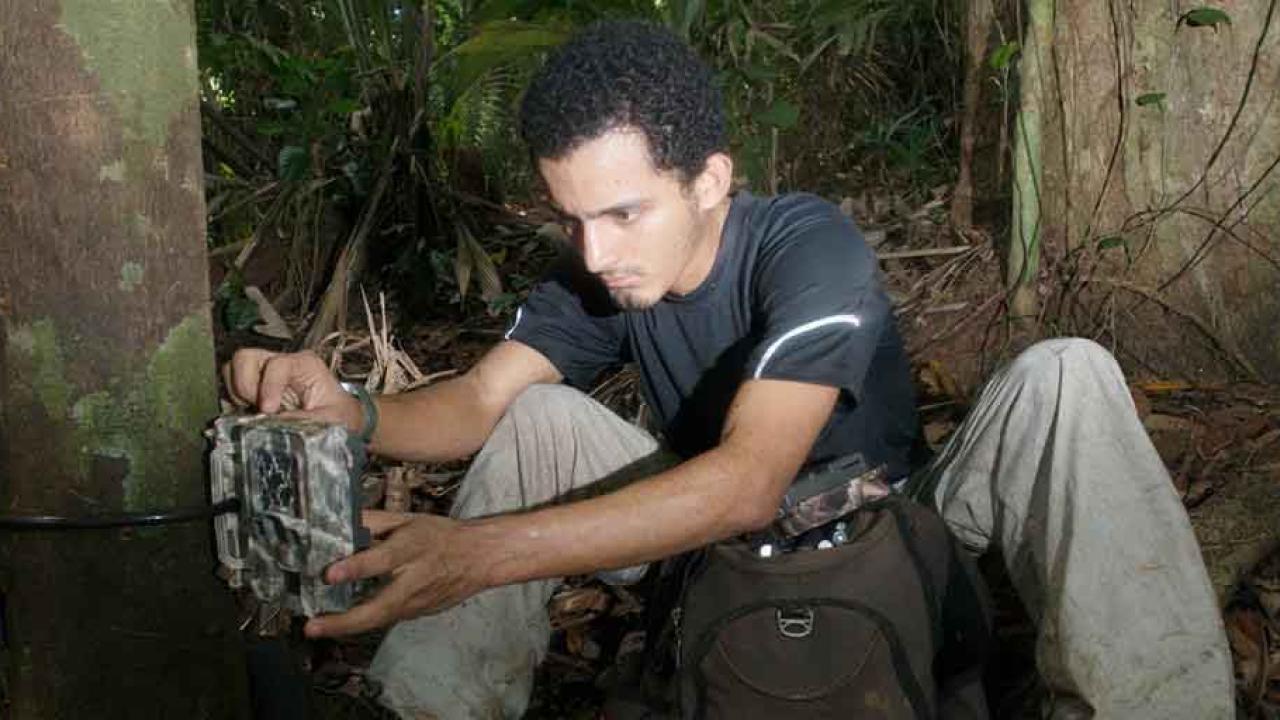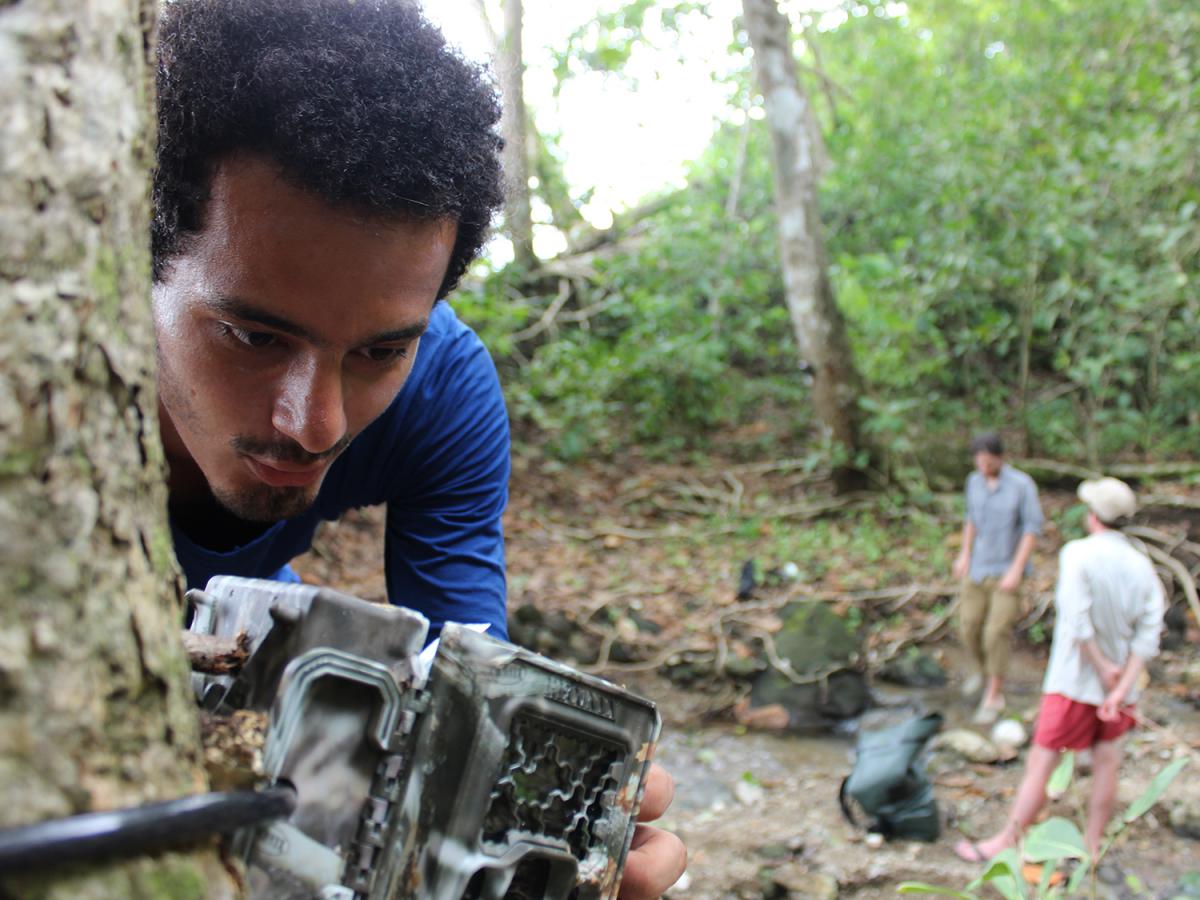
From Tool Use in Primates to Animal Movement: Animal Behavior Graduate Student Claudio Monteza-Moreno
Behind Claudio Monteza-Moreno’s childhood home in David, Panama, a stream runs nearby a patch of forest. Monteza-Moreno spent his adolescence exploring this backyard ecosystem, observing the iguanas, turtles, fish and snakes that crawled, swam and slithered across the landscape. He was fascinated with coloration, especially when it came to snake scales. Vibrant mosaics, they entranced Monteza-Moreno with their architecture.
These experiences opened Monteza-Moreno’s mind to science and eventually brought him to UC Davis. Today, he’s a student in the Animal Behavior Graduate Group, working in the lab of Associate Professor Margaret Crofoot, Department of Anthropology, College of Letters and Science.
While not specifically studying the mosaic of snakeskin, Monteza-Moreno is interested in a different type of mosaic—those created by the movements of mammals across landscapes—specifically in areas reforested by humans.
“That’s the reason why I came to UC Davis because we have Dr. Crofoot and she works on the movement of animals,” said Monteza-Moreno.
Monteza-Moreno spent his adolescence exploring the ecosystem in his backyard in Panama. Courtesy photo
His research concerns reforested sites within Panama, focusing on land surrounding the Panama Canal and Panama City, the most densely populated area of the country. According to Crofoot, not only is this region central to Panama’s economy, it’s also critical to connecting Central American animal populations to the “untouched forests of the Darién Gapand the rest of South America.”
“My question is, how are animals navigating this space or these territories in these human-influenced areas?” Monteza-Moreno said.
This information could eventually help researchers understand whether human efforts to restore disturbed environments are working. But beyond that, it could be a brushstroke in a bigger painting of species distribution across North and South America.
Building a foundation as a naturalist
When Monteza-Moreno first met Crofoot in 2012, he had just started out as a naturalist guide with the Smithsonian Institute on Barro Colorado Island, located in the man-made Gatun Lake in the middle of the Panama Canal. As part of their training, the guides were exposed to the latest research about the island, so they could relay the information to tourists. Crofoot gave them a presentation about her ongoing studies on non-human primates on the island.
“My first memory of Claudio is him asking some extremely difficult questions about my interpretation of some data we had collected on a large mortality event in the Barro Colorado Island primate population,” said Crofoot. “The fact that he was willing to challenge me and argue about the cause of all these deaths was what initially impressed me about him.”
In 2015, Monteza-Moreno assisted Crofoot with work for a project called Food for Thought, which probes questions concerning how humans evolved bigger and better brains by studying brain expansion as a general pattern across primate species. One idea behind brain expansion is that it’s facilitated by a higher quality diet. Monteza-Moreno helped the team obtain a map of individuals of Dipteryx panamensis, a tree on Barro Colorado Island that the animals love. The researchers wanted to further explore non-human primate foraging behaviors in the trees’ canopy environments. While assisting with the project, Monteza-Moreno shared his ambitions to one day attend a Ph.D. program with Crofoot.
“I had no clue two years later, I’d be in her lab,” he said.

Mysterious tool use
Around the time Monteza-Moreno enrolled at UC Davis, he started assisting Crofoot and former graduate student Brendan Barrett, Ph.D. ’17 Animal Behavior, with a project concerning a curious rumored behavior from white-faced capuchin monkeys (genus Cebus) in Coiba National Park, a marine reserve off Panama’s coast. Rumor had it that a group of these monkeys on an island in the park exhibited stone tool use. Up until that point, such behaviors had only been observed in three wild primate genera, including chimpanzees, robust capuchins and macaques.
To confirm the behavior, the team set up camera traps across the three islands and collected 205 days of footage with evidence of tool use. Publishing in Royal Society Open Science, the team reported that male capuchins from a single group on the island habitually used stone tools to access nuts and hermit and halloween crab meat. The researchers noted that the tool use appeared to be localized to a single group and wasn’t present in other populations of the species.
“We don’t know what’s going on,” Monteza-Moreno said of this localization. He surmises that the lack of predators on the island may have facilitated the development of the monkeys’ curiosity, encouraging them to expand their range from the safety of the trees and eventually develop tool use. The islands of Coiba National Park have been isolated from the mainland of Panama since the last glaciation, roughly 12,000 years ago.
Future studies will seek to assess the movement of males within this group of stone tool users as they mature and disperse. By doing this, researchers hope to understand why tool use knowledge isn’t spreading to other groups on the island.
Exploring animal movement
While Monteza-Moreno will remain involved in the capuchin research, it’s separate from his dissertation research on animal movements in reforested areas surrounding the Panama Canal.
According to Monteza-Moreno, the canal’s construction created geographic barriers for some of Panama’s wildlife, potentially disrupting distribution ranges. The increased economic activity also attracted more people to the area. The resulting population expansion led to drastic reductions in forest cover.
Though restoration efforts are ongoing, whether reforestation works in the region is something Monteza-Moreno and other researchers hope to figure out.
“What we don’t know is how animals are doing in these manmade habitats,” he said, noting that animals of interest include ocelots, white-tailed deer and cougars, among others. “I’m interested in seeing how many species are coming to these new niche environments.”
“That will let us know if we are on the right track for success,” he added.
About Graduate Studies at UC Davis
Graduate Studies at UC Davis includes over 100 dynamic degree programs and a diverse and interactive student body from around the world. Known for our state-of-the-art research facilities, productive laboratories and progressive spirit – UC Davis offers collaborative and interdisciplinary curricula through graduate groups and designated emphasis options, bringing students and faculty of different academic disciplines together to address real-world challenges.
UC Davis graduate students and postdoctoral scholars become leaders in their fields: researchers, teachers, politicians, mentors and entrepreneurs. They go on to guide, define and impact change within our global community.
